Embark on a sensory journey to the bustling streets of Northern Thailand with our irresistible Khao Soi recipe. This iconic dish, beloved for its rich coconut curry broth and tender noodles, encapsulates the essence of Thai culinary tradition. Imagine the vibrant markets of Chiang Mai, where the air is perfumed with the aroma of spices and sizzling noodles. Each spoonful of Khao Soi promises a harmonious blend of savory and spicy flavors, complemented by crispy toppings that add texture to every bite. Whether you're craving a taste of exotic travels or seeking to recreate authentic Thai cuisine at home, Khao Soi invites you to explore its cultural heritage and savor the warmth it brings to your table. Get ready to elevate your culinary repertoire with this delectable journey into Thailand's flavorful culinary tapestry.
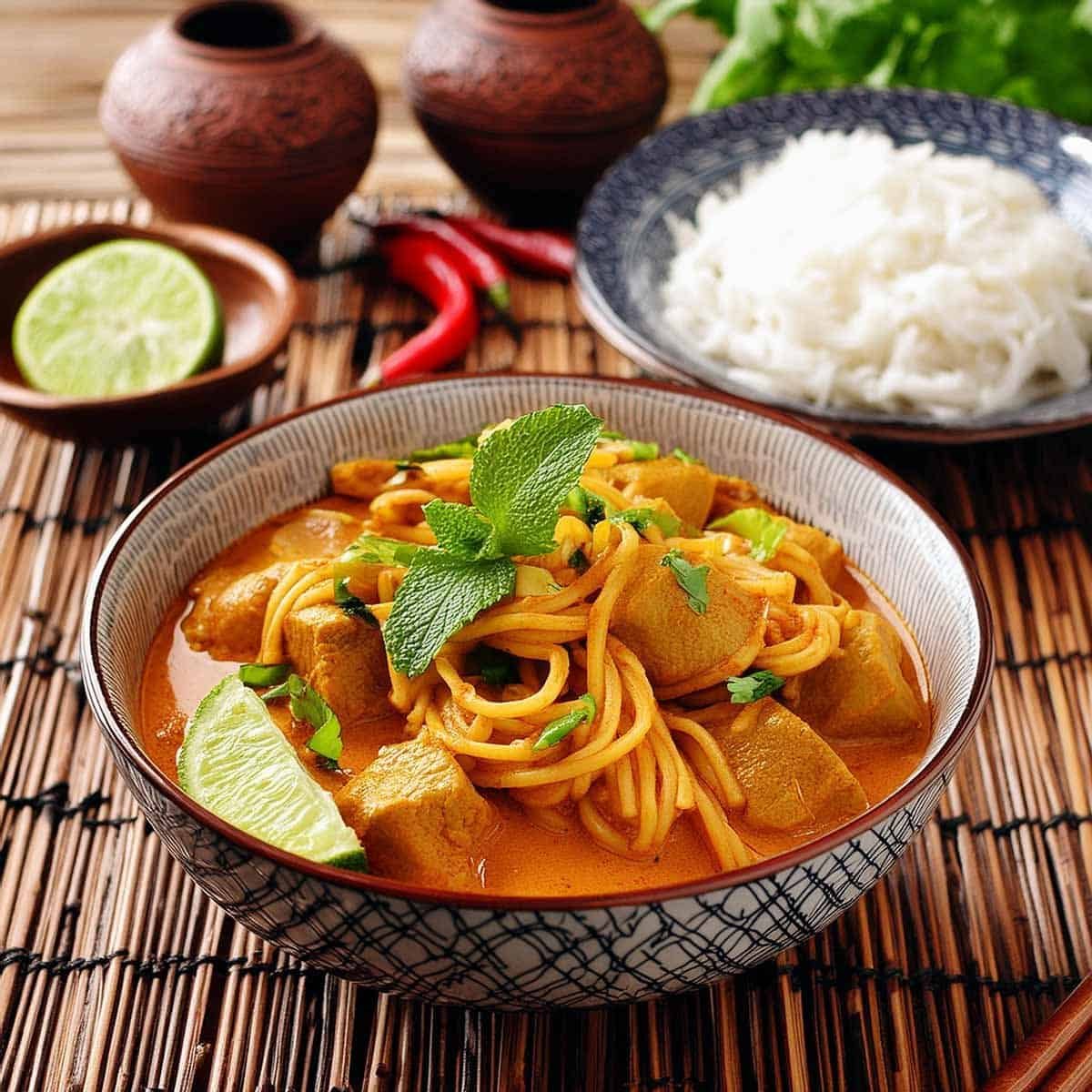
Historical Background and Influence of Thai Curry Noodles (Khao Soi)
Khao Soi traces its origins to the diverse culinary landscape of Northern Thailand, particularly around the city of Chiang Mai. This dish reflects the region's historical influences, blending traditional Thai flavors with elements believed to have been introduced by Chinese Muslim traders centuries ago. Prepared initially with wheat noodles, Khao Soi evolved to incorporate local ingredients such as coconut milk, curry spices, and choice cuts of meat like chicken or beef. Today, it symbolizes Northern Thai cuisine's fusion of flavors and cultural exchange, celebrated for its comforting richness and depth. Beyond its local popularity, Khao Soi has garnered international acclaim, captivating food enthusiasts worldwide with its complex flavors and aromatic allure. Join us as we delve into the history and preparation of this beloved dish, inviting you to experience a taste of Thailand's culinary heritage firsthand.
I've spent years perfecting my version of Khao Soi.

Sawasdee Kha, and Hello
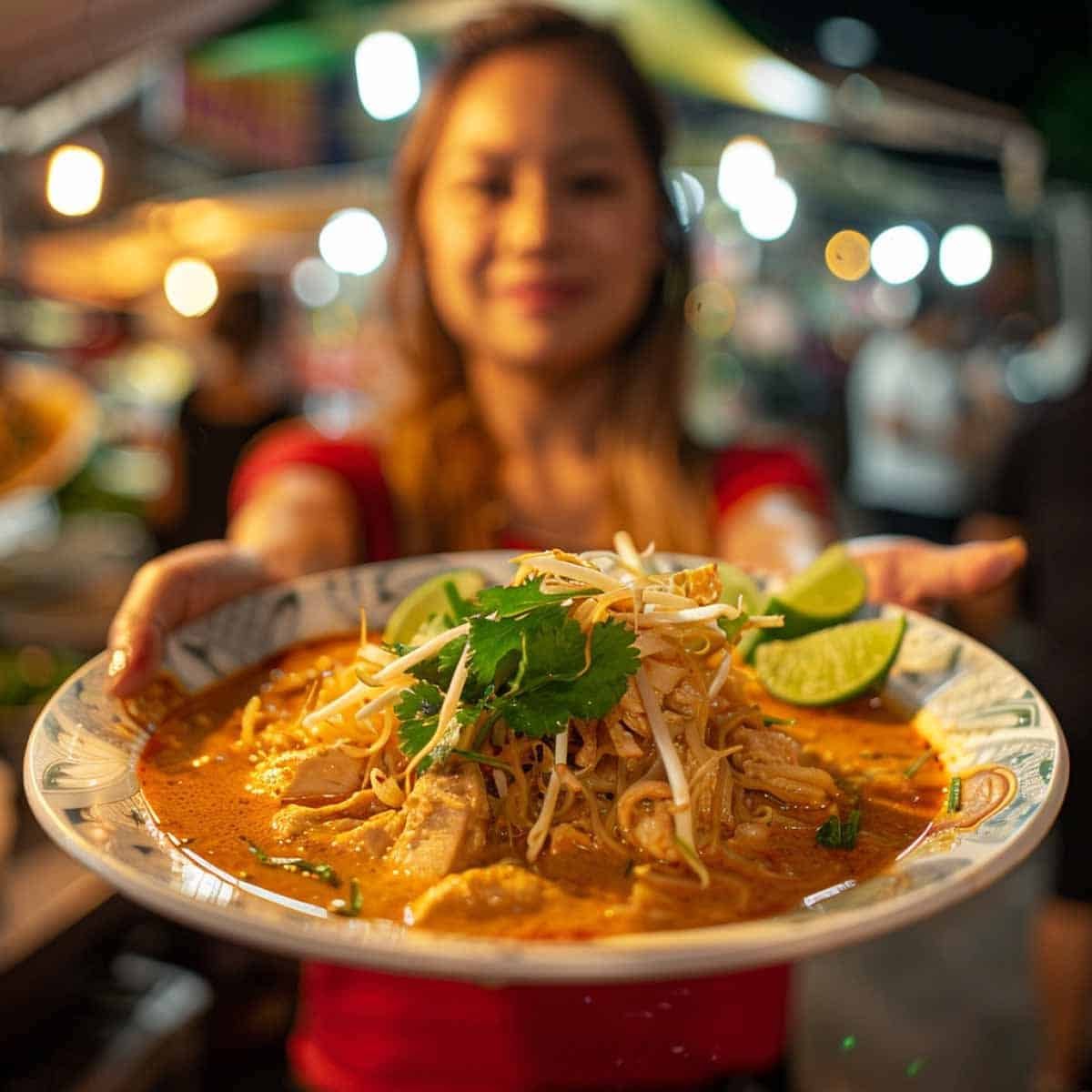
Khao Soi was more than just a dish in our household—it was a gateway to flavors and memories that shaped my love for Thai cuisine. My family gathered around steaming bowls of this comforting curry noodle soup, each spoonful a burst of creamy coconut, fragrant curry, and tender noodles. The crispy toppings added a delightful crunch, making every bite a lovely adventure.
Recreating Khao Soi in my kitchen is a sensory experience that takes me back to those cherished moments of togetherness and discovery. The sight of golden broth simmering on the stove, the aroma that fills the kitchen with warmth, the rich taste that lingers on the palate, and the satisfying textures—it's a nostalgic journey with every spoonful.
I'm thrilled to share this recipe with you, and I hope it brings as much joy to your table as it has mine. Dive into the flavors of Thailand, and remember to share your experience in the comments below. Your stories and creations are a valuable part of our culinary community!

WELCOME TO MY HOUSE! COME MAKE THIS Thai Curry Noodles (Khao Soi) WITH ME!
Ingredients
The ingredient list for Khao Soi celebrates the fusion of local produce and aromatic spices. Key components include chicken thighs for richness, coconut milk for creaminess, and spices like turmeric and curry powder that paint a vivid taste portrait.
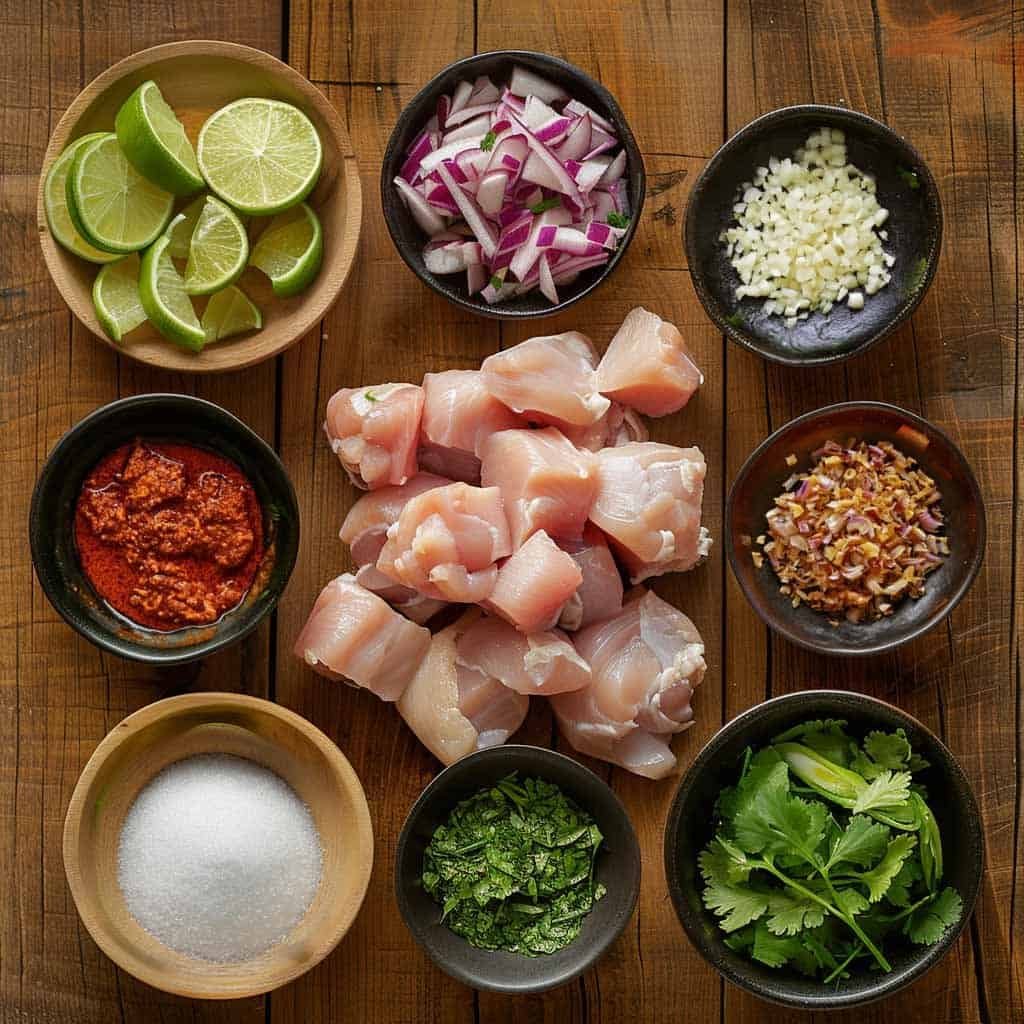
See the recipe for actual ingredients and quantities.
Preparing the Noodles
Begin by cooking the dried egg noodles according to package instructions until they are al dente. This ensures they are perfectly tender yet firm to the bite, ready to absorb the flavors of the curry broth.. Deep-fry the remaining noodles until crispy, then drain them on paper towels.
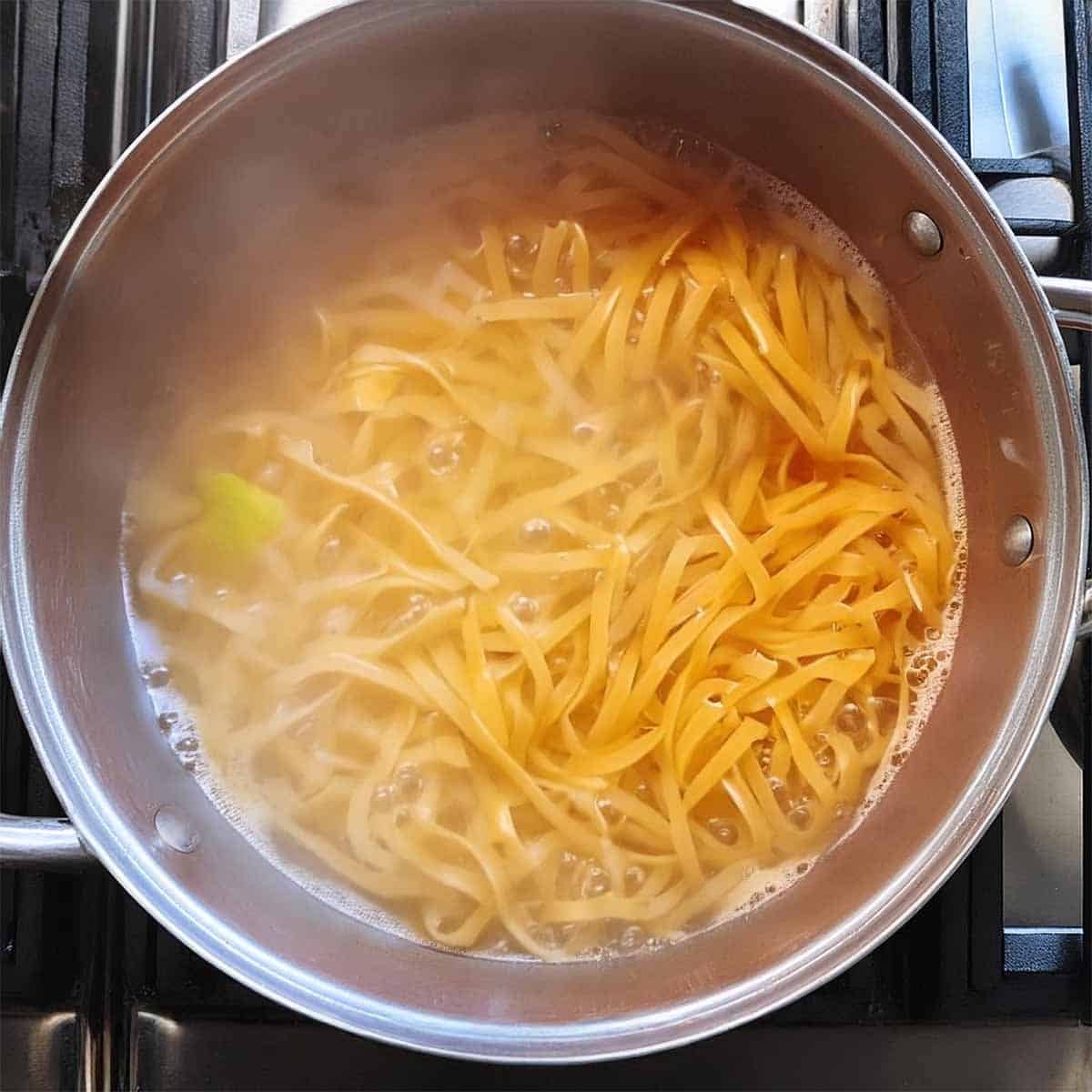
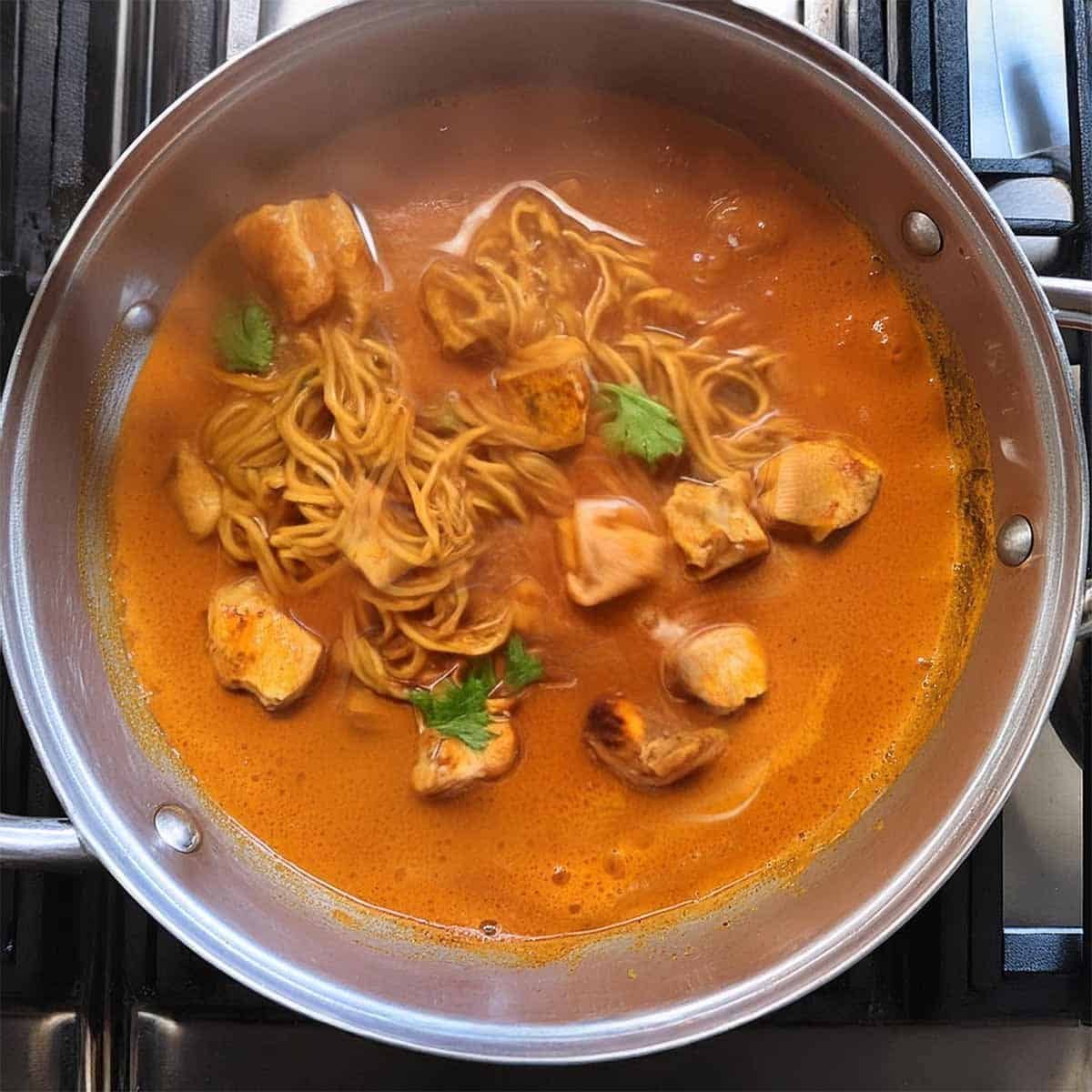
Preparing the Curry Base/Incorporate Coconut Milk and Broth
Heat vegetable oil in a large pot over medium heat. Add the red curry paste and stir-fry for 1-2 minutes until fragrant. This step helps release the curry paste's aromatic oils and flavors.
Pour in the coconut milk and the chicken or vegetable broth. Stir well to combine, ensuring the creamy coconut milk blends evenly with the savory broth for a rich and velvety base.
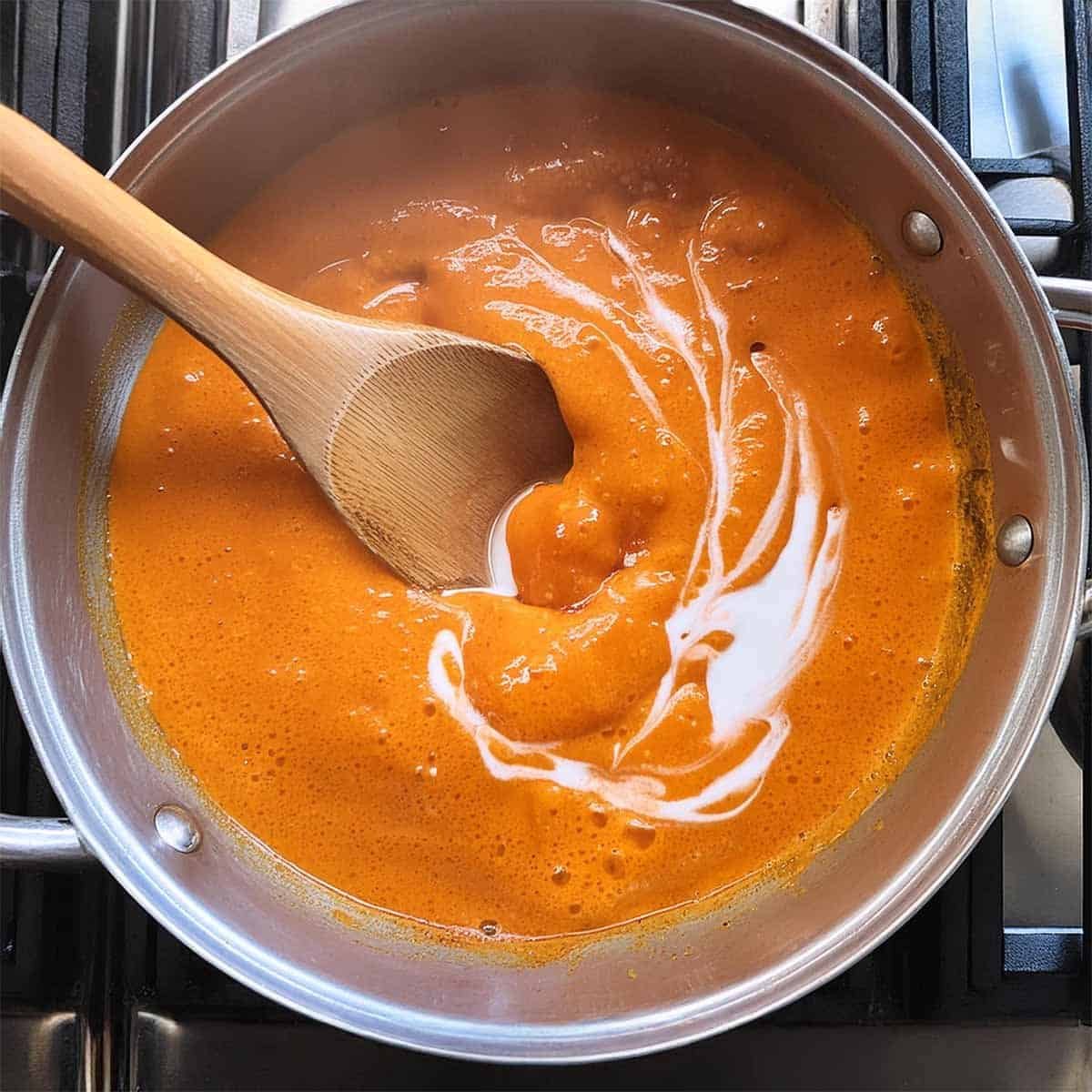
Seasoning with Flavors/Cook the Chicken or Tofu
Add soy sauce, fish sauce, palm sugar, turmeric powder, and curry powder if using. Mix the ingredients well into the broth to distribute the flavors evenly throughout the dish.
Place the thinly sliced chicken thighs or tofu into the simmering broth. Allow them to cook for approximately 8 to 10 minutes or until the chicken is fully cooked through or the tofu is heated evenly.
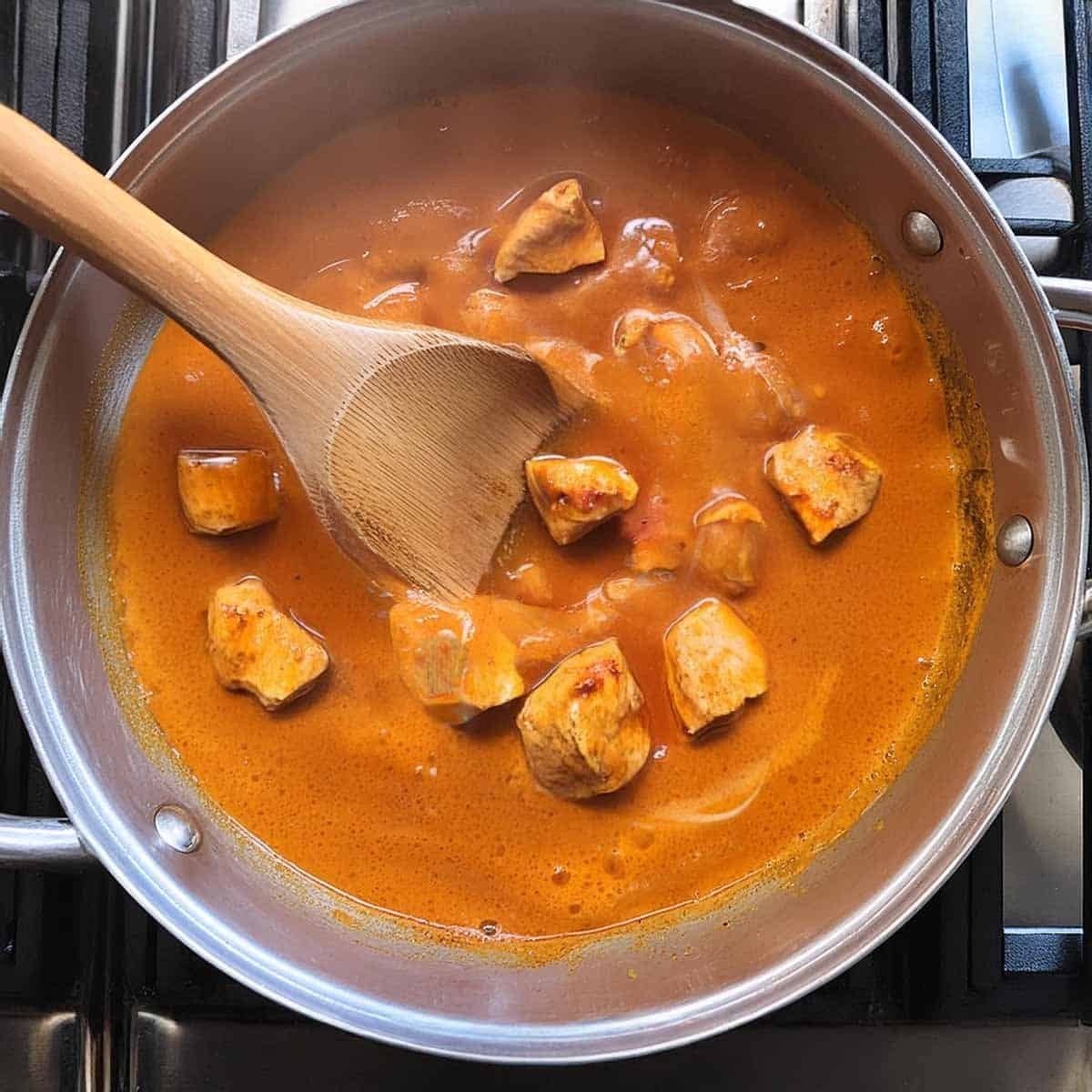
Assembling the Dish
Serve the Khao Soi dish hot in individual bowls. Each portion should include noodles, chicken or tofu, and a ladleful of coconut curry broth. Garnish with fresh cilantro and a lime wedge. Top with crispy fried noodles for a delightful crunch. Enjoy immediately to savor the harmonious blend of flavors and textures.
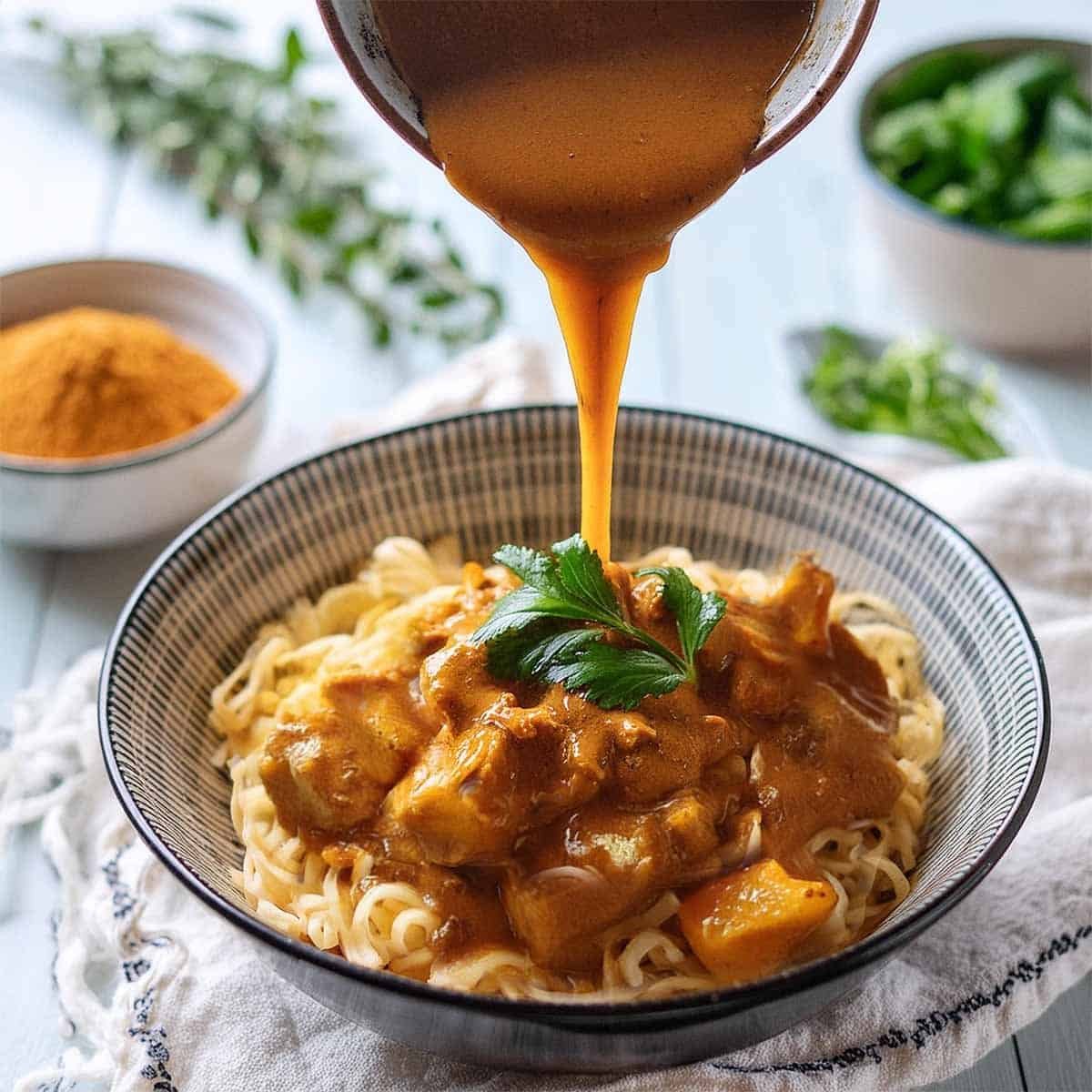
Tips for Authenticity and Customization
Using Authentic Ingredients
To achieve an authentic Khao Soi, prioritize sourcing high-quality, traditional ingredients. Start with dried egg noodles, preferably the thin variety used traditionally in Thai cuisine, which absorbs the curry broth effectively. For the curry paste, opt for a well-balanced red curry paste that includes authentic Thai ingredients like dried red chilies, lemongrass, galangal, and kaffir lime leaves. Coconut milk should be full-fat and creamy, providing a rich base for Khao Soi's flavor profile. Use fresh chicken thighs for tender meat that absorbs the flavors of the broth beautifully or tofu for a vegetarian option, ensuring it's firm and able to hold up in the curry. Palm sugar adds a subtle sweetness, while fish sauce adds depth (optional for vegetarians). Fresh cilantro and lime wedges for garnish complete the dish authentically, offering a burst of herbal freshness and citrusy tang.
Adjusting Spiciness and Flavors
Khao Soi's versatility allows for easy adjustment of spiciness and flavors to suit individual preferences. Add red curry paste gradually to increase spiciness, tasting as you go until the desired heat level is achieved. Reduce the red curry paste or dilute it with more coconut milk or broth for a milder version. Balance the flavors by adjusting the amounts of soy sauce for saltiness, palm sugar for sweetness, and lime juice for acidity. To deepen the savory notes, increase the amount of fish sauce if using. For those who prefer a richer broth, let the curry simmer longer to intensify flavors before adding the noodles. Remember, Khao Soi is about finding the perfect balance of savory, sweet, spicy, and tangy flavors, so feel free to experiment until you discover your ideal combination.
Substitutions
- Protein: Replace chicken with shrimp, beef, or a mix of vegetables and tofu for a vegetarian version.
- Noodles: Use rice noodles or gluten-free noodles for a gluten-free option.
- Coconut Milk: Substitute with coconut cream for a richer texture, or use light coconut milk for a lower-fat version.
- Curry Paste: Opt for yellow curry paste for a milder flavor or green curry paste for a spicier alternative.
- Fish Sauce: Replace soy sauce or tamari with a vegetarian or vegan version, adjusting saltiness to taste.
- Garnishes: Use chopped scallions, fried shallots, or crushed peanuts instead of crispy fried noodles for added texture.
Alternative Garnishes
Fresh Herbs: Thai basil or mint leaves impart a refreshing herbal essence, enhancing the aromatic complexity of the dish with their unique fragrance.
Crushed Peanuts: These provide a delightful crunch and nutty undertones, adding texture and depth to each spoonful of Khao Soi.
Fried Shallots: Offering a savory and crispy topping, fried shallots elevate the dish with their rich, caramelized flavor and satisfying crunch.
Chili Oil: A drizzle of chili oil not only adds extra heat but also intensifies the flavors of the curry broth, enhancing the overall spiciness and complexity of the dish.
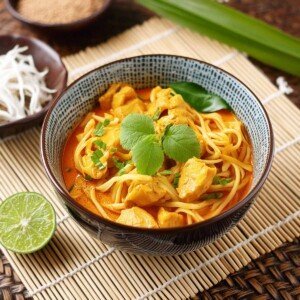
Thai Curry Noodles (Khao Soi)
Ingredients
- 8 oz dried egg noodles
- 1 lb chicken thighs boneless and skinless, thinly sliced ) OR tofu for a vegetarian option
- 2 tablespoon vegetable oil
- 1 can 14 oz / 400ml coconut milk
- 2 cups chicken or vegetable broth
- 3 tablespoon red curry paste
- 2 tablespoon soy sauce
- 1 tablespoon fish sauce optional, for non-vegetarian
- 1 tablespoon palm sugar or brown sugar
- ½ teaspoon turmeric powder
- ½ teaspoon curry powder
- Salt to taste
- Fresh cilantro leaves chopped, for garnish
- Lime wedges for serving
- Crispy fried noodles for topping
Instructions
- Prepare the Noodles: Cook the dried egg noodles according to package instructions until they are al dente, firm, yet tender. Drain them well and set aside, ready to soak up the flavors of the curry broth.
- Prepare the Curry Base: Heat vegetable oil over medium heat in a large pot. Add red curry paste and stir-fry for 1-2 minutes until it becomes fragrant and releases aromatic oils.
- Add Coconut Milk and Broth: Pour in the coconut milk and chicken or vegetable broth, stirring well to combine. Bring the mixture to a gentle simmer, melding the flavors into a rich, creamy base.
- Season the Curry: Add soy sauce, fish sauce (if using), palm sugar, turmeric powder, and curry powder to the pot. Stir vigorously to dissolve the sugar and ensure even distribution of the spices. Taste and adjust seasoning with salt as needed to balance the flavors.
- Cook the Chicken or Tofu: Carefully add the sliced chicken thighs or tofu to the simmering broth. Let them cook gently for 8-10 minutes, ensuring the chicken is thoroughly cooked, or the tofu is heated through and infused with the broth's flavors.
- Assemble and Serve: Divide the cooked noodles evenly among serving bowls. Ladle the hot curry broth over the noodles, ensuring each bowl receives a generous amount of flavorful broth. Garnish each serving with a handful of fresh cilantro leaves and a sprinkling of crispy fried noodles for added texture and crunch.
- Serve with Lime Wedges: Serve Khao Soi piping hot and lime wedges on the side. Squeezing fresh lime juice over the noodles just before eating adds a refreshing citrusy zing that enhances the dish's complexity and brightens the flavors.
Notes
Nutrition
Frequently Asked Questions
Khao Soi is unique because it uses both boiled and crispy fried noodles and its distinct, slightly spicy coconut curry broth.
Absolutely! Beef or pork can be substituted for chicken; adjust the cooking time accordingly.
The broth should be creamy yet soupy. Adjust the amount of coconut milk and broth to balance the thickness.
To make your Khao Soi experience truly authentic, remember to add crispy fried onions, lime wedges, pickled mustard greens, and fresh herbs.
Tasting Notes for Thai Curry Noodles (Khao Soi)
- Visual: Khao Soi presents with vibrant colors of golden broth, creamy coconut milk, and garnishes of green cilantro and crispy noodles.
- Aroma: The aroma is rich with spices like curry and turmeric, complemented by the fragrance of coconut milk and fresh herbs.
- Taste: It offers a balanced combination of savory, creamy coconut, spicy curry, and a hint of sweetness from palm sugar.
- Texture: The dish boasts contrasting textures with tender noodles, succulent chicken or tofu, and crispy fried noodles, adding crunch, all bathed in a velvety broth.
Pairing Suggestions And Side Dishes
- Side Dish Suggestions:
- Jasmine Rice: Absorbs the rich curry broth and complements the dish's flavors.
- Thai Cucumber Salad: Refreshing with a tangy dressing that balances the spiciness of Khao Soi.
- Stir-fried Vegetables: Light and crunchy, offering a contrast in texture.
- Fresh Spring Rolls: Provide a light and fresh accompaniment.
- Wine Pairings:
- Riesling: Its sweetness and acidity complement the spicy and creamy flavors of Khao Soi.
- Pinot Grigio: Crisp and light-bodied, refreshing the palate between bites.
- Gewürztraminer: Floral and aromatic, enhancing the dish's exotic spices.
- Beer Pairings:
- Leo Super: Clean and crisp, it balances well with the richness of Khao Soi.
- Singha: Classic Thai beer refreshes with a hint of bitterness.
- Chang: Full-bodied and malty, it complements the dish's bold flavors.
Serving and Storage Tips
How to Serve
- Serve Khao Soi hot and freshly prepared in individual bowls. Start by portioning cooked noodles and ladling the aromatic coconut curry broth over them, ensuring each bowl has a generous amount of tender chicken or tofu. Garnish with fresh cilantro and crispy fried noodles for added texture. Serve with lime wedges on the side to squeeze over the noodles and enhance the dish's flavors. Pair with jasmine rice or a side salad for a complete meal.
Reheating Options
- To reheat Khao Soi, gently warm it in a saucepan over low heat, stirring occasionally to prevent sticking. If needed, Add a broth or water to maintain the desired consistency. Alternatively, stir up individual portions in short intervals to ensure even heating.
Make-Ahead and Storage
- Khao Soi can be prepared by preparing the curry base and storing it separately from the noodles and protein. Store in airtight containers in the refrigerator for up to 2 days. Reheat the curry base on the stovetop, then add freshly cooked noodles and protein before serving. Leftovers can be stored in the refrigerator for up to 3 days or frozen for up to 1 month in suitable containers.
Required Kitchen Equipment
- Large Pot: Use this to simmer the coconut curry broth and cook the chicken or tofu, ensuring ample space for the broth to develop rich flavors while the protein cooks to tender perfection.
- Saucepan: Utilize a saucepan to cook the noodles separately. This ensures the noodles are prepared al dente and ready to absorb the flavors of the curry broth without becoming overcooked or mushy.
- Ladle: This is essential for portioning and serving the piping hot Khao Soi. The ladle allows you to scoop and distribute the broth and ingredients evenly into individual serving bowls, ensuring each serving is flavorful and well-balanced.
- Chef's Knife: Use a sharp chef's knife to slice the chicken thighs or tofu precisely. This ensures uniform slices that cook evenly in the simmering broth, enhancing both the texture and taste of the dish.
- Cutting Board: Use a sturdy cutting board for preparing ingredients such as slicing chicken, chopping herbs like cilantro for garnish, and other necessary preparations. A clean and spacious cutting surface facilitates efficient and organized meal preparation.



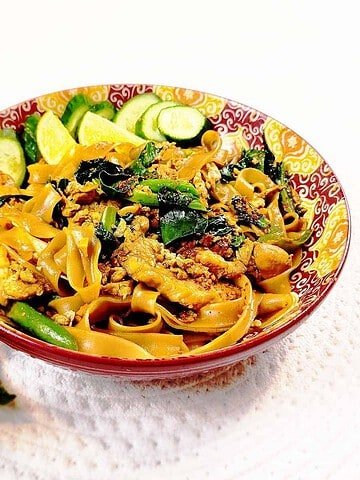
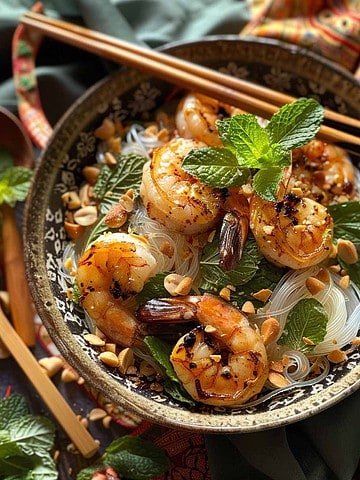
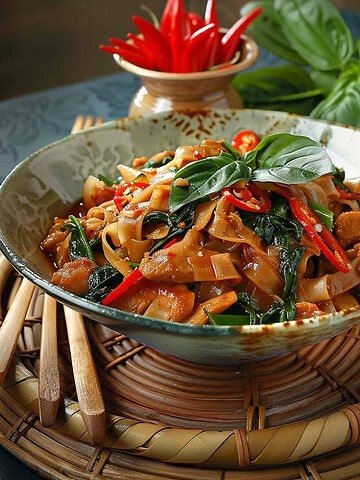
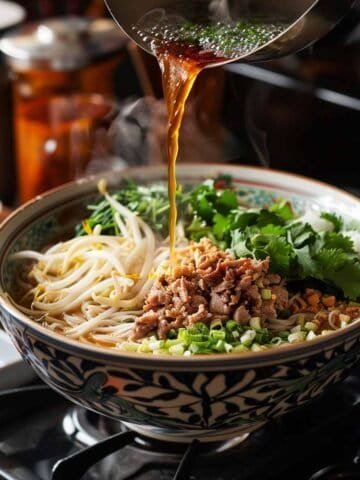
Leave a Reply